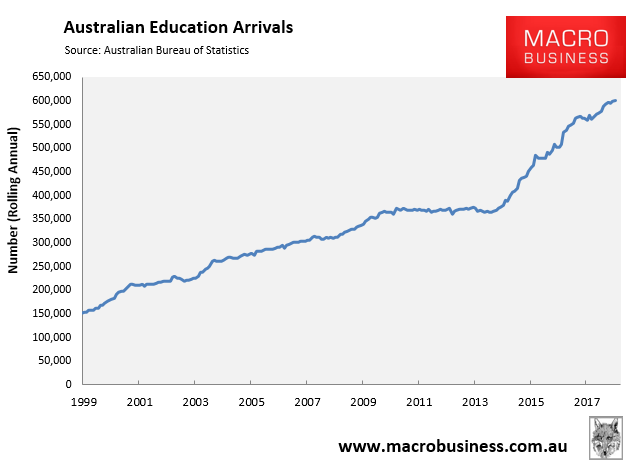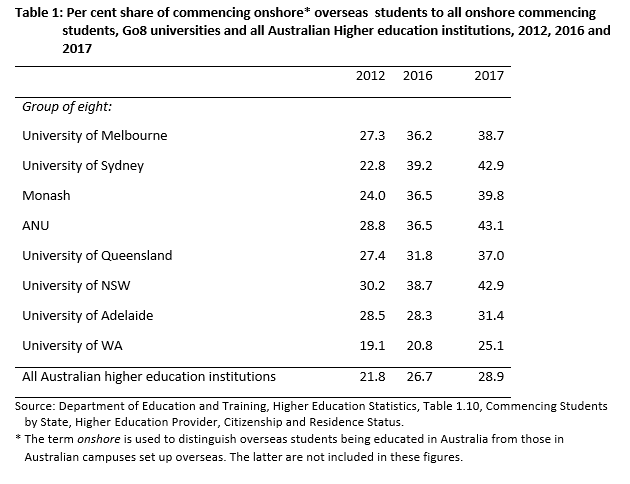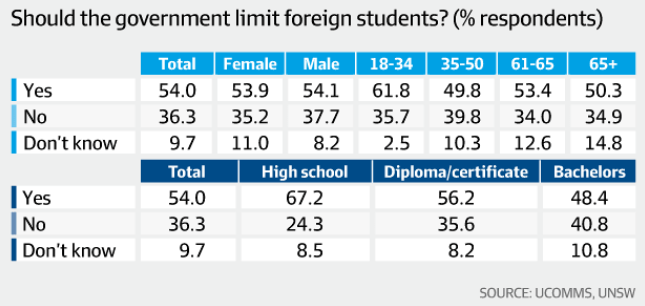Back in December, the higher education program director at the Grattan Institute, Andrew Norton, warned that Australia’s universities have become dangerously reliant on Chinese students.
This warning came after a near doubling of international student arrivals over the past five years:

Alongside a ballooning of the international student share at Australia’s universities, driven by the ‘big four’: ANU, University of Sydney, University of NSW, and Monash University:

Over the weekend, University of NSW Professor, Ian Jacobs, warned that Chinese students studying in Australia will decline over the next decade as China increases investment in its own universities and lifts its standards. From The Canberra Times:
“They are getting more universities, and those are getting much better quality, very rapidly,” said Professor Jacobs. “The Chinese government understands education is everything if they are going to be the high tech country they aspire to be.”
“My assessment [is] over a 10-year period, [Chinese students] will gradually decrease. We are already starting to see a slight decrease in the number of undergraduate students from China as the opportunities increase.
Jacobs’ assessment makes sense.
Australia’s universities have become dependent financially upon international students. And the need to attract, year in and year out, huge numbers of international students has impacted on the prestige-value of an Australian qualification in the international market-place.
University standards have also plummeted in a bid to keep student numbers (and profits) flowing. There is continuous pressure not to be too demanding on international students when it comes to language skills, and if possible, to pass low performing students as they undertake their courses.
The situation has become so bad that the Victorian Government in January called for a review of entry requirements into Australia’s universities after growing evidence had emerged that international students with poor English language proficiency are badly eroding education standards and placing undue strain on lecturers and university staff.
This was immediately followed by academics admitting to Fairfax that they had lowered teaching standards and passed failing international students in order to maintain the foreign student trade.
The international student association also called for greater regulation of overseas migration agents amid widespread cheating on English tests to gain access to Australian universities.
Whereas three recent Australian reports (here, here and here) raised the alarm that the flood of international students had degraded Australian university standards.
The above factors are compounded by increasing competition from universities abroad (including from China) as their standards improve. This will make it increasingly difficult to attract high quality students from China or elsewhere, who are more likely to study at home (or abroad).
Unlike with commodities, Australia has no natural advantage in university education. And one of the reasons why education exports grew so much in the first place was because they are a pathway to Australian residency. I’d even go as far to say that Australia is primarily selling residency rather than education.
The Australian’s Judith Sloan nicely encapsulated the issue with the following comment:
To sell overpriced degrees to overseas students, it is necessary to be able to offer the byproduct of permanent residence for graduates. Any reduction in the immigration numbers would make that sell quite a bit harder. No doubt, there was a bit of wink-and-nod between the government and the vice-chancellors on this topic.
The lobby group representing foreign students in Australia – the Council for International Students in Australia (CISA) – also point blank admitted that students come here to migrate, not because of the quality of education on offer:
The Council for International Students in Australia said foreign potential students were attracted to Australia by the possibility of migrating here…
The national president of CISA, Bijay Sapkota, said… “For people coming from low socio-economic backgrounds there has to be a value proposition. If they go home they will not get value. So there has to be a possibility of immigration.”
In other words, if the incentive of permanent residency was removed, then Australia’s attractiveness as a place to study would evaporate and the international student trade would collapse.
A recent national survey from the University of New South Wales revealed the majority (54%) of Australians want international student numbers to be limited:

Whereas a variety of recent opinion polls showed the majority of Australians want immigration to be lowered, including:
- Australian Population Research Institute: 54% want lower immigration;
- Newspoll: 56% want lower immigration;
- Essential: 54% believe Australia’s population is growing too fast and 64% believe immigration is too high;
- Lowy: 54% of people think the total number of migrants coming to Australia each year is too high;
- Newspoll: 74% of voters support the Turnbull government’s cut of more than 10% to the annual permanent migrant intake to 163,000 last financial year;
- CIS: 65% in the highest income decile and 77% in the lowest believe that immigration should be cut or paused until critical infrastructure has caught up;
- ANU: Only three out of 10 Australians believe the nation needs more people.
Given Australia’s education system has effectively become an integral part of the immigration industry and the federal government’s ‘Big Australia’ policy, any pullback in Chinese student numbers would likely be welcomed by the community.
Not only would it ease population pressures in our major cities, but it would help to arrest the decline in standards necessary to attract increasing numbers of international students year after year.

